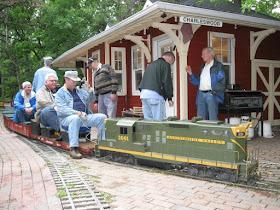Like
many other things during the pandemic, the Gateway Spur has been shut down.
Unlike
the real world, it wasn’t loss of traffic or customers or supplies or even to
prevent the transmission of the virus.
It
was simple loss of interest and energy.
It’s
not like I wasn’t busy at other things; as a religion reporter for my local
newspaper, my work continued unabated as I reported about the impact of the
pandemic on faith groups.
And
the little NGO I work part-time for had to do all sorts of recalibrations to
adjust to the new reality.
I
also started biking more, an hour or so each evening to stay fit and keep my
mind off the loss of so many things because of the (stupid) pandemic.
I also
read 8 or 9 books—a record for me. In normal times, it can take me a month to
get through one.
But
in other ways, the pandemic really weighed on me. Sports, concerts, festivals
and so many other events all cancelled. Even if I was never going to go to or
take in them all, I felt their absence keenly.
It
was a sort of existential loss, a void that seems to last forever.
This
lack of energy carried over to model railroading, I found it hard to be
motivated to do anything on the layout.
I
went down to the train room only a few times to run some trains—never mind
think about doing scenery.
For me,
the energy for the hobby just wasn’t there. Or for this blog, which I haven’t updated
since April 22.
Am I
the only one who felt this way?
I
know some haven’t. People like Jason Shron of Rapido Trains has used the time
at home productively to make some brilliant scenery on this layout.
Which is
amazing, considering he was also trying to keep his company afloat and keep
three kids busy at home at the same time.
Others
on the Canadian Railway Modellers group have posted photos of their modelling
during the pandemic.
Since he’s in the
higher-risk age group for catching the virus, Kevin Day stayed inside completed
two kits he bought about 35 years ago.
Jon
Calon of Calgary found a silver lining in the pandemic, noting a lot of sign
shops and places that produce the clear sneeze guards are likely to be awash in
scraps of material.
"Those scraps work wonderfully for model railway owners wanting to protect details and rolling stock close to the edge of the layout," he wrote.
"I just scored (free!) a couple of 8' long chunks of clear polycarbonate that are about 10" tall."
Daniel Charest used the lockdown to add a mine to his N scale layout. This area was a piece of plywood before the pandemic started.
Nick Eh used the "COVID crap" time, as he called it, to model CP GP38-2 3031, a unit that brought back good memories from when he was a kid.
And
good on John Strickland and the Mississippi Valley Associated Modelers in the
Ottawa area found a way to combine social distancing with running trains by
setting their modules up outside.
As for me, maybe things will change in fall modelling-wise. Summer always was a slow time, anyway. Perhaps things will be different in the fall for the pandemic and my energy. We can only hope.




































